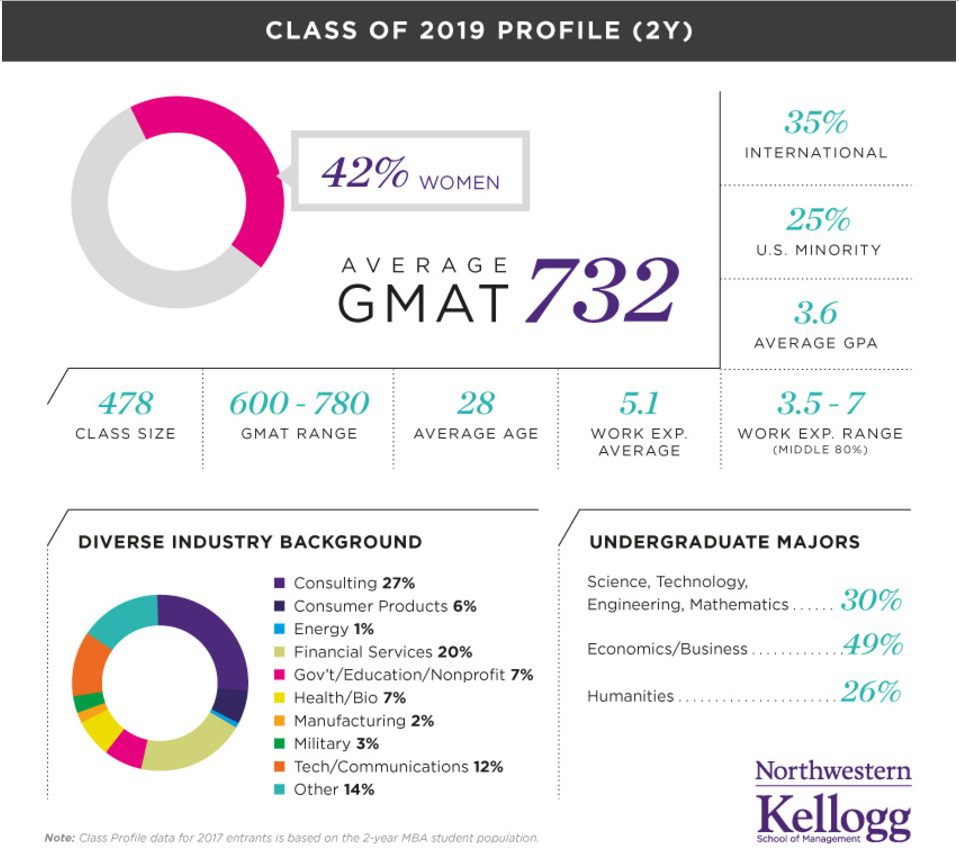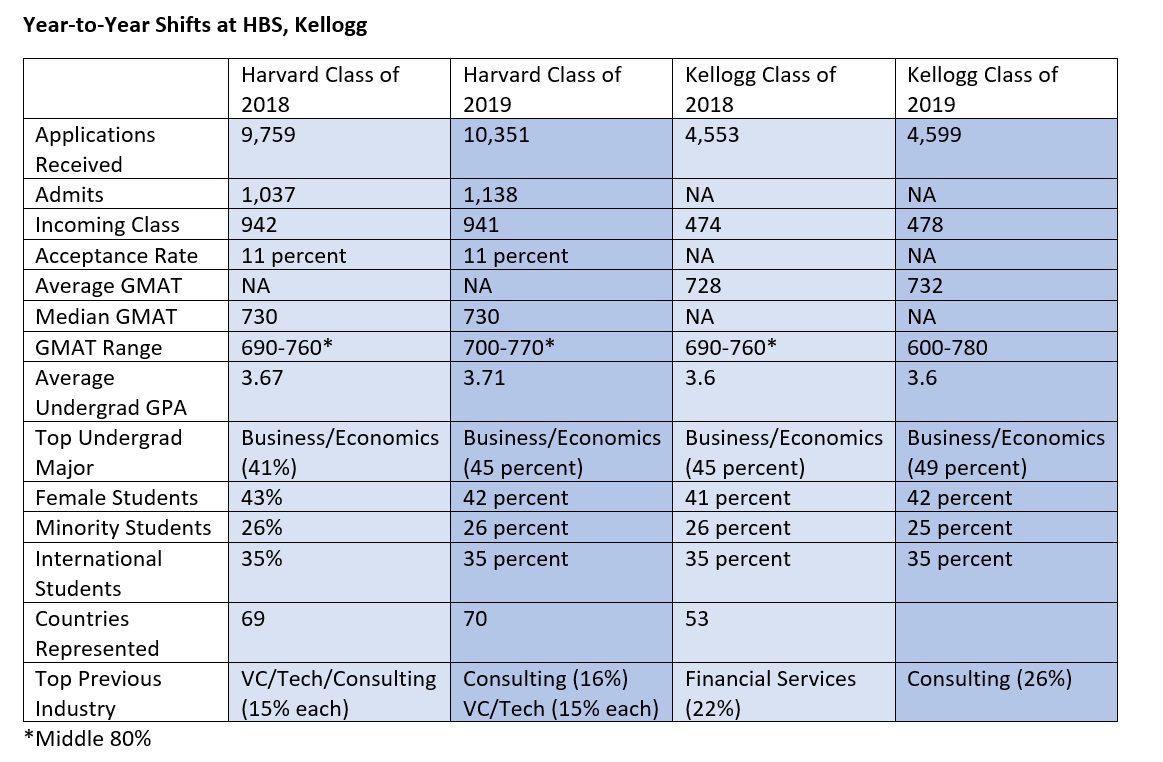How to Deal with a Bad GMAT Score

You’ve been studying for months, possibly losing sleep as you go over the practice questions in your head and, as a result, getting some oh-so-enjoyable stress dreams. If any of this sounds familiar, you probably have had to—or currently are—preparing to take that Graduate Management Admission Test (GMAT).
What MBA Class of 2019 Profiles from HBS, Kellogg Reveal about YOUR Admission Chances

Northwestern’s Kellogg School of Management last week released a profile of its incoming Class of 2019, and Harvard Business School (HBS) earlier this summer released its own preliminary Class of 2019 profile. (The Boston school notes there could be subtle shifts come late August when the final class matriculates.) A look at both reveals that this past admissions cycle was a competitive one with few major shifts from the year before. It also shows some striking similarities between the incoming class compositions at the two schools.
Application Volume Increases
HBS clearly outperformed Kellogg in terms of application volume. At HBS, applications rose from 9,759 in 2015-2016 to 10,351 in 2016-2017, a 6 percent increase. The school maintained its stringent 11 percent acceptance rate, second only to Stanford’s, which has historically hovered around the 6-percent mark. Total enrollment this year is 941, down from 942 last year. According to the school, yield this year was 91 percent, which means more than nine of 10 accepted students decided to enroll.
At Kellogg, applications rose a more modest 1 percent over last year. Melissa Rapp, Kellogg Director of Admissions, characterized application volume as “steady” in an interview with Clear Admit earlier this summer. The single percentage point increase included slight upticks in domestic applicants as well as those from some international markets, which offset declines in applicants from other international markets, she says. Applications totaled 4,553 last year, which puts this year’s number closer to 4,600. Overall, 478 students comprise the incoming class, up from 474 in the Class of 2019.
Kellogg Continues Its GMAT Ascent
But where GMAT scores are concerned, Kellogg outshone HBS. HBS reported a median GMAT score of 730—identical to the two prior years. HBS does not share average GMAT score data, but it does reveal that the middle 80 percent of the class submitted scores between 700 and 770.
Kellogg, which shares average GMAT score, saw this metric rise another four points over last year, to 732. It’s the continuation of a multi-year increase for the Evanston school that just five years ago had an average GMAT score of 708. Its meteoric rise places it second only to Stanford Graduate School of Business where this metric is concerned, barring significant jumps at other schools that have not yet reported average scores for the incoming class. (Stanford GSB doesn’t release its incoming class profile until later in the fall, but last year’s average GMAT score was 737.) Kellogg’s overall GMAT score range was between 600 and 780. Last year, the range was 690 to 760—but last year’s data only reflects the middle 80 percent range, before Kellogg started reporting full range.

Undergraduate GPA, Major
In terms of average undergraduate GPA, HBS saw slight gains over last year, up to 3.71 from 3.67. At Kellogg, average GPA stayed the same as last year, at 3.6. As for what applicants studied while in college, both schools showed a greater preference for business backgrounds this year than last. At HBS, 45 percent of the incoming class majored in business or economics, up from 41 percent the year before. STEM majors were next, at 36 percent, with humanities majors bringing up the rear at just 19 percent. (Last year, STEM majors accounted for 38 percent, humanities majors, 21 percent.) At Kellogg, 49 percent of this year’s incoming class majored in business or economics, up from 45 percent of the previous class. STEM majors, meanwhile, made up 30 percent (up from 29 percent the year before), and humanities majors rounded out the class, at 26 percent (compared to 28 percent last year).
Class Diversity Similar at Both Schools
In terms of class diversity, both Kellogg and HBS will welcome incoming classes that are 42 percent women, down slightly from 43 percent at HBS and up slightly from 41 percent at Kellogg. Forty-three percent has thus far proven the high-water mark at both institutions.
At HBS, 35 percent of the class is international, and 26 percent belongs to U.S. ethnic minorities—mirroring last year’s stats. Kellogg’s incoming class is also 35 percent international, though U.S. minorities are 25 percent, a percentage point decline since last year. Still, Kellogg notes that this year’s class is among the school’s most diverse ever.
At HBS, the incoming class counts students from 70 countries, though 69 percent of students are from North America and 65 percent are from the United States. Students from Asia make up 14 percent of the class, with Europeans comprising another 10 percent. Student from Central and South America make up another 4 percent of the class, and 2 percent—or 16 students—hail from Africa.
Varied Professional Experience
Both schools tout the varied professional experience represented by the incoming class. At HBS, those from a consulting background make up 16 percent of the class, followed closely by venture capital and private equity, which each comprise another 15 percent. The financial services category makes up 11 percent, followed by government/education/nonprofit, healthcare/biotech, and other services (each at 7 percent); consumer products and energy (6 percent each), and finally manufacturing and military (each at 5 percent). HBS shared that the average age of those in the incoming class is 27, though no details about average years of work experience were made available.
HBS Touts Its Diversity in Video Entitled “Mosaic of Perspectives”
Kellogg, meanwhile, shows a greater predilection toward applicants from a consulting background, who make up 27 percent of this year’s incoming class. Applicants who have worked in financial services follow, at 20 percent; “other” makes up 14 percent, and those from a tech/communications background make up 12 percent. Other less represented backgrounds include government/education/nonprofit and healthcare/bio (each 7 percent), consumer products (6 percent), military (3 percent), manufacturing (2 percent), and energy (1 percent). Average work experience at Kellogg this year is 5.1 years, with 80 percent of the class having between 3.5 and 7 years. The average age of the incoming class is 28.
Rapp expressed great enthusiasm about both the diversity and high quality of the group of students who are just now arriving on campus, noting that theirs will be the first class that will get to enjoy Kellogg’s gorgeous new Global Hub for their entire time in business school. “As we do every year, we looked for leaders that are focused on collaborating to create impact and lasting value wherever they go—before Kellogg, during their time at Kellogg, and in the future,” she said. “Our comprehensive approach to admissions enables us to attract an incredibly well-rounded group of students to Kellogg. The quality of the applicant pool has increased this year, and the quality of our accepted students is commensurate with that.”
Chad Losee, HBS managing director of MBA admissions and financial aid, shared fewer words but no less enthusiasm. “So hard to capture the talent and diversity of perspectives in this group. They are amazing!” he wrote on his Director’s Blog.

This article has been edited and republished with permissions from Clear Admit.
MBA Startups At The Kellogg School of Management

With entrepreneurship on the rise throughout the country and world, business schools are finding new ways to accommodate and educate students looking to flex their entrepreneurial muscles. Both in and outside of the classroom, support for entrepreneurship and MBA startups can take many forms—from networking opportunities to competitions for capital to resume building internships.
At the Kellogg School of Management at Northwestern University, there are a number of ways business students can build their entrepreneurial skills and put them quickly into practice. At the Kellogg Institute of Innovation & Entrepreneurship and Levy Entrepreneurial Institute , Kellogg students have the chance to secure funding for their entrepreneurial projects, expand their business network and even set up opportunities that will continue even after graduation.
Below are just a few of the many resources Kellogg provides for innovative students to turn their ideas into reality.
Events
Kellogg events are a great way for students to forge new business connections and explore the many potential MBA startups already in motion at the school. Below are some of the events available to students throughout the year.
Corporate Renewal Conference: Every year, the Kellogg Corporate Renewal Conference gathers together students and industry leaders to explore a particular theme in the current business climate. The inaugural conference, which took place in October 2014, was themed ‘Corporate Renewal through Innovation: Ways to Invigorate Growth and Scaling.”
Kellogg eChats: Kellogg eChats were created by students to give MBAs the chance to meet leading thought leaders in business. Offered monthly, students are given a chance to meet and pose questions of these leaders on the topic of technology and business.
Student Treks: Kellogg Student Treks are trips led by students to cities throughout the United States, with the goal of visiting anywhere from 4-12 companies which represent a wide scope of business environments and industries. The treks can range from one day to multiple days over school breaks, and allow students to connect with industry professionals and Kellogg alumni.
Competitions
Events like the Kellogg Venture Challenge, VentureCat and the Venture Capital Investment Challenge (VCIC) give students the chance to put their startup ideas to the test and gain valuable feedback from industry leaders. These competitions can offer anywhere from $10,000 in prizes to $100,000 at the VentureCat Competition, distributed to student ventures. Students also have the chance to participate in an international competition, the Venture Capital Investment Challenge, which invites 78 students from around the world to compete at the Kenan-Flagler Business School in North Carolina.
Student Entrepreneurship Opportunities
A number of opportunities exist for students while enrolled at Kellogg that can provide capital for startup ideas and help students create a community of entrepreneurs. Here are just a few:
FOUNDER.org 8D Program: The FOUNDER.org program provides funding for students with ideas for high-impact ventures. Students are eligible to receive up to $100k in grant money, with the chance to apply for further investment opportunities ranging from $250k to $3 million. Students participating in the program also receive the benefits of having a virtual mentor, one-on-one coaching from industry innovators, and the chance to attend quarterly forums.
Kellogg Entrepreneurs Organization: The KEO is a community of students working to create new ventures, providing support during the process of launching and building a new business. Students have the chance to receive feedback from a network of mentors made up of professors, investors, and top entrepreneurs.
Pritzker Group Venture Fellows: Students with an idea for a business startup can apply to join the Pritzker Group Venture Fellows, a 12-week summer fellowship created to support young entrepreneurs in Chicago. Two teams of fellows will be awarded witha $20,000 investment, mentorship, and a work space at 1871.
Summer Entrepreneurship Opportunities
Kellogg Entrepreneurship Internship Program Stipend: Kellogg students have the chance to participate in a summer internship that will allow them to get a first-hand look into working in the entrepreneurship field. Student internships, which can be located anywhere throughout the globe, will give students the chance to gain direct experience in analyzing pricing models, exploring exit strategies, market research and more. Kellogg students accepted to the internship program are eligible to receive a matching stipend up to $5,000.
Startup Stipend: If students are committed to building their own venture over the summer break and have proven a product-market fit for their idea are eligible to obtain a stipend of up to $7,000 to use for their business needs.
Post-Graduate Entrepreneurship Opportunities
Even after graduation, Kellogg offers a number of awards that can provide funding opportunities and promote the MBA startups of Kellogg grads.
Kellogg Social Entrepreneurship Award: The Social Entrepreneurship Award is available for graduates with an idea to use their business knowledge for a positive social impact. Those selected for the award will receive assistance from the Entrepreneurship Lab and Kellogg Social Entrepreneurship Fellow Award to fund a startup idea that addresses today’s most pressing social challenges.
NewDay Social Entrepreneurship Award: The NewDay Social Entrepreneurship Award is available for graduates with an idea for a new impact venture with a social and/or environmental mission in the Chicagoland area which has demonstrated some market traction. This competition is also open to undergraduate and graduate students throughout Northwestern.
Financing Your MBA, Part I

As more and more of you are receiving your admissions results from all your hard work during the MBA application process, we wanted to turn our attention to how you’ll manage financing your MBA.
If you’ve got a spare couple hundred thousand dollars in your bank account, then you can probably skip this series. For everyone else, read on. In this post and a handful to follow, we’ll provide a broad overview of the various costs a typical MBA student faces and the types of funding opportunities currently available. Down the line, we’ll take a closer look at the financial aid processes at a diverse range of leading business schools, giving you the tools you need to assess MBA programs in light of both your own goals and available financing options.
If you’re just beginning to think about an MBA, this series can help map out the landscape, outlining the financial aid process and resources available at various programs. You can extend your research by consulting the Clear Admit School Guides and schools’ own websites, as well as through conversations with current students.
First Things First: What’s an MBA Going to Cost?
The first step in financing the MBA is getting a handle on how much it will cost. The primary expense of an MBA program is tuition. Having said that, there are a variety of other costs—including living expenses, course materials and additional fees—that can increase the total amount a student pays by a half again. Most business schools provide a breakdown of the expenses, which are posted under the financial aid or admissions section of their websites in order to help prospective students seriously consider the cost of completing a particular MBA program. Schools typically take the total cost of attendance into account when calculating the financial aid package students receive.
Tuition
Tuition at the top business programs has risen steadily for decades, often at a rate above inflation. Students can now expect to pay between $50,000 and $75,000 for a single year’s tuition at a top school, with an average total price tag of $130,000 for tuition alone. Public universities, which discount tuition for state residents, can sometimes be more affordable. For instance, in-state residents attending schools such as UT Austin’s McCombs and UNC’s Kenan-Flagler pay about $15,000 less in tuition each year than do out-of-state residents. The range of variance of costs that in-state residents pay can be explained in part by the different levels of subsidies that public universities receive and the economies of the states in which they are located.
Living Costs
The cost of living also forms a substantial part of a student’s expenses while at business school. These costs typically cover housing, food, utilities and other personal expenses, and they can vary widely by geographic region. For example, the Fuqua School of Business, located in the college town of Durham, North Carolina, estimates that students will pay $12,800 for room and board in their first year. Meanwhile, at NYU Stern, located in the center of Manhattan in New York City, the estimated cost for room and board is $25,170.
Living costs are usually based on surveys of the student population or estimates of local rental costs. Students should keep in mind that the figures posted by most schools are for single students with no dependents; those with partners or children should take into account the additional expenses of balancing family life with full-time studies. Harvard Business School, for instance, estimates that students with a spouse or partner should set aside an additional $16,900 in yearly expenses for a spouse or partner, another $13,100 for one child and an additional $8,500 for a second child. Meanwhile, Tuck, with its rural New Hampshire campus, calculates that $7,500 should be set aside for each additional family member. Prospective students with further questions may contact their target programs’ financial aid offices in order to request information about expected family expenses.
Additional Expenses and Fees
Course materials, healthcare insurance, transportation costs and other mandatory university fees can add several thousand dollars to a student’s expenses each year. For example, Wharton’s Pre-term fee is $2,000. Furthermore, extracurricular activities, particularly international trips that are often a highlight of an MBA experience, can substantially increase costs; for example, the Kellogg Worldwide Experience and Service Trips (KWEST) run into the thousands before considering a number of additional out-of-pocket expenses. To help cover these expenses, some schools allow students to apply for an increase to their cost of attendance and thereby take on more loans.
Loan Interest
Because recent legislature has rendered federally subsidized loans unavailable for U.S. citizens or permanent residents in graduate school, students relying on loans to fund their studies will see their interest accumulate while in business school. For the most part, students do not have to start paying that interest, or the principle, until several months after they graduate. Federal loans and some private loans also include an ordination fee that is tacked on to each loan disbursement. We’ll go into greater detail on loans in a later post in this series.
Stay tuned for future posts in this series, where we’ll take a closer look at the range of financing options available to MBA students—including school-based financial aid, private scholarships and loan programs—as well as specific resources for international students.
The Top 10 Business Schools Where MBAs Leave With A Job

U.S. News & World Report has just unveiled its findings on the best business schools in the country for MBAs to earn a job upon graduation.
More Tech Hires at Kellogg, Per 2016 Employment Report

‘Tis the season for MBA employment reports, and one of the latest schools to share details about how its most recent class of graduates fared in their quest for jobs is Northwestern’s Kellogg School of Management. Released in its entirety last week, the report shows a surge of graduates heading off toward technology firms—22 percent of the class, up from 15 percent last year.
“I do think the tech story jumps out,” says Liza Kirkpatrick, director of career management for the full-time MBA program. “But we really are very proud of this year’s employment outcomes overall.” She went on to cite the fact that 96 percent of students received an offer within three months of graduation, up slightly from 95 percent the year before. The median base salary was $125,000, up $2,000 from the year before.
Consulting, long the destination for the majority of Kellogg grads, still drew one in every three—33 percent—though this represents an ever-so-slight dip from the 35 and 36 percent in each of the past four years. Financial services, which drew 19 percent of last year’s class and 20 percent two of the three years before that, dipped to just 13 percent this year, the most significant downward shift of any industry.
According to Kirkpatrick, the drop off in financial services could be nothing more than a reflection of the aspirations of this particular class. “We look at it as just an indication of the interest of the Class of 2016,” she says, noting that 14 percent of the class took finance internships during the summer between their first and second years, in line with the 13 percent who took full-time offers.
Not Surprisingly, Salaries Highest in Consulting, Financial Services
Though student interest in financial services is lower than it has been, it’s certainly not because of waning paydays. The highest starting salary of the class—$250,000—went to a graduate going into private equity. Median starting salaries for students headed into financial services were $125,000. Overall, consulting led the way in terms of pay, with a median starting salary of $145,000 for these graduates.
Technology trailed slightly, with a median starting salary of $120,000, although Kirkpatrick was quick to point out that salaries for those entering more technical roles at technology firms remain very high. “The more technical your skills are, the higher your base compensation will be,” she says. Stock options and other non-salary compensation also factor into the allure of tech jobs, she adds. “Stock options are very attractive, and we see tech companies using those to attract talent whether for technical or non-technical roles,” she says. Unlike some other schools, Kellogg does not include information about non-salary compensation as part of its employment report. Median signing bonuses were $25,000 for consulting and technology, bested by a median bonus of $32,500 for financial services.
Diversity of Jobs, Employers the Real Story
More than money, it’s the diversity of tech jobs that seems to be drawing Kellogg students, Kirkpatrick says. “There is such wide variety in the types of tech jobs our students take,” she says, noting that graduates went everywhere from very small companies like Narrative Science to medium-size companies like Uber to large firms like Google. They also went into a wide range of functions and an array of sub-sectors, from software to hardware, mobile to the “Internet of Things.”
Both in technology and beyond, the breadth of hiring companies is the real story in Kellogg’s most recent employment report, says Kirkpatrick. “What stands out for me most is the diversity and range of employers that come to Kellogg,” she says. “They are looking at our students—who have a balanced and dynamic skillset, excellent general management skills, the emotional intelligence to motivate teams and make an impact and a global perspective—and they are finding places for them in their organizations.”
There has also been an increase in data-related jobs, she adds. “There’s such a surge in data, and we are increasingly seeing employers look at the MBA skillset as a solution to that,” she says. “We continue to see a broad breadth of employers come to Kellogg, but we also see that how they are using the MBA in their organizations is evolving, too.”
In terms of absolute numbers, McKinsey snapped up more Kellogg grads than any other firm, hiring 43 members of the Class of 2016. Boston Consulting Group and Bain & Co. followed, hiring 25 and 24 respectively. In tech, Amazon led the way, luring 23 grads, followed by Google with 12 and Apple with 10. Notably, companies hiring three or more students accounted for just over half (290) of the jobs, with the other half split between scores of firms each taking just one or two grads, underscoring Kirkpatrick’s point about breadth.
Outside of these numbers were the roughly 15 percent of the class—95 students—who were company-sponsored and returning to their employers. As well, 13 students were focused exclusively on starting their own business, a slight uptick from 11 last year, but still representing just 2 percent of the overall class.
Career Services Adjusts to Changing Recruitment Landscape
As the nature of recruiting has become more diverse, so, too, have the services Kirkpatrick and her team offer. On the employer side, the Kellogg Career Management Center (CMC) has a team of business development leads working to create opportunities for students across industries, geographies and companies. On the student side, a team of one-on-one coaches works intensively to help students identify their target companies and understand what their recruitment journey will look like. If it does evolve to an off-campus process—as is the case for a growing percentage of the class—a personal coach is available to help them navigate it successfully. “What we offer is very customizable to what the student is looking for,” Kirkpatrick says.
“We are always looking at ways to improve our services to students,” she continues. “We do find that students coming in have an increased demand for one-on-one coaching. Students want to have a relationship with their coach, someone who understands their story and can help them achieve their goals. In Kellogg’s CMC we pride ourselves in knowing our students and how to help them on their job search journey.”
Though traditional on-campus recruiting has remained a very robust channel at Kellogg, Kirkpatrick says, the trend toward off-campus, just-in-time recruiting is something she and her team are paying close attention to. “As students’ interests expand, Kellogg’s Career Management Center services and support evolve to support every students unique job search.”
To view the 2016 Kellogg MBA Employment Report, click here.
This article has been republished with permissions via Clear Admit.
